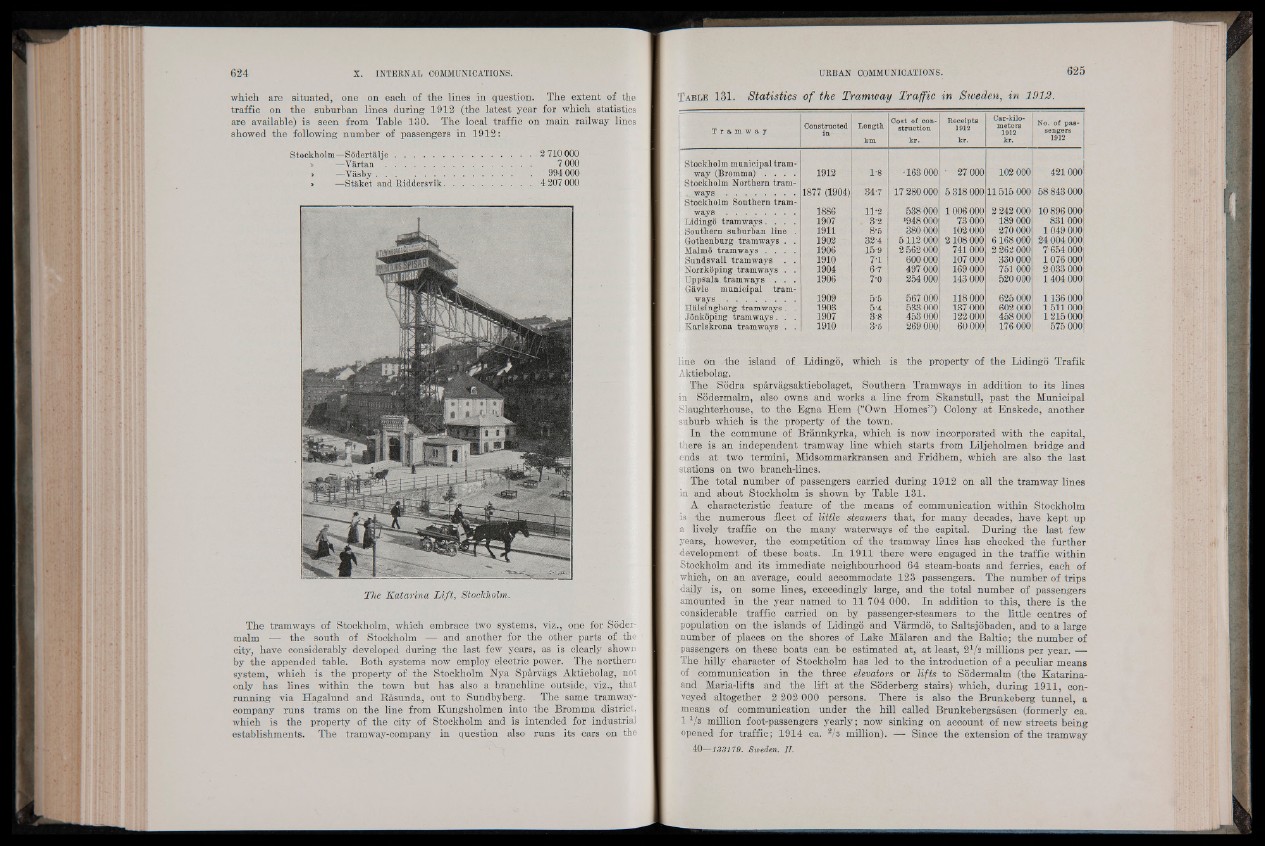
which are situated, one on each of the lines in question. The extent of the
traffic on the suburban lines during 1912 (the latest year for which statistics
are available) is seen from Table 130. The local traffic on main railway lines
showed the following number of passengers in 1912:
Stockholm—Sodert&lie...........................................................2 710 000
» —V & r ta n ..................................................................... 7 000
I if -V a s b y ....................... 994000
> 1H—Staket and Riddersvik.................................... 4 207 000
The Katarina L ift, Stockholm.
The tramways of Stockholm, which embrace two systems, viz., one for Soder-
malm — the south of Stockholm Sslland another for the other parts of the
city, have considerably developed during the last few years, as is clearly shown
by the appended table. Both systems now employ electric power. The northern
system, which is the property of the Stockholm Nya Spârvags Aktiebolag, not
only has lines within the town but has also a branchline outside, viz., that
running via Hagalund and Râsunda, out to Sundbyberg. The same tramway-
company runs trams on the line from Kungsholmen into the Bromma district,
which is the property of the city of Stockholm and is intended for industrial
establishments. The tramway-company in question also runs its cars on the
T able 131. Statistics of the Tramway Traffic in Sweden, in 1912.
T r a m w a y
Constru cted
in-
L en g th
km
Cost of cons
tru c tio n
k r.
Receipts
1912
k r.
Car-kilom
ete rs
1912
k r.
No. of p a s sengers
1912
Stockholm municipal tramway
(Bromma) . . . . 1912 1*8 •163 000 ■ 27 000 102 000 421000
Stockholm Northern tram-
. w a y s ............................ 1877 (1904) 34-7 17 280 000 5 318 000 11515 000 58 843000
Stockholm Southern tramways
............................ 1886 11-2 538 000 1006 000 2 242 000 10 896 000
Lidingo tramways. . . . 1907 I 3-2 *948 000 73 000 189 000 831000
Southern suburban line . 1911 8-6 380 000 102 000 270000 1 049 000
Gothenburg tramways . . 1902 324 5112 000 2 108 000 6 168 000 24 004 000
Malmö tramways . . . . 1906 15-9 2 562 000 741 000 2 262 000 7-654 000
Sundsvall tramways . . 1910 7-1 600 000 107000 330 000 1076 000
Norrkôping tramways . . 1904 6-7 497 000 169 000 751 000 2 033 000
Uppsala tramways . . . 1906 7-0 254000 143 000 520 000 1404 000
Gavle municipal tramways
-, , .................... 1909 55 567 000 118 000 625 000 1136 000
Hàlsingborg tramways. . 1903 5'4 533 000 137000 602 000 1 511 000
I Jônkoping tramways. . . 1907 3-8 453 000 122 000 458000 1215 000
Karlskrona tramways . . 1910 3-5 269 000 60000 176000 575 000
line on -the island of Lidingo, which is the property of the Lidingo Trafik
Aktiebolag.
The Sodra sparvagsaktiebolaget, Southern Tramways in addition to its lines
in ‘Sbdermalm, also owns and works a line from Skanstull, past the Municipal
Slaughterhouse, to the Egna Hem (“Own Homes”) Colony at Enskede, another
suburb which is the property of the town.
In the commune of Brannkyrka, which is now incorporated with the capital,
there is an independent tramway line which starts from Liljeholmen bridge and
ends at two termini, Midsommarkransen and Fridhem, which are also the last
stations on two branch-lines.
The total number of passengers carried during 1912 on all the tramway lines
in and about Stockholm is shown by Table 131.
A characteristic feature of the means of communication within Stockholm
is the numerous fleet of little steamers that, for many decades, have kept up
a lively traffic on the many waterways of the capital. During the last few
years, however, the competition of the tramway lines has checked the further
development of these boats. In 1911 there were engaged in the traffic within
Stockholm and its immediate neighbourhood 64 steam-boats and ferries, each of
which, on an average, could accommodate 123 passengers. The number of trips
daily is, on some lines, exceedingly large, and the total number of passengers
amounted in the year named to 11 704 000. In addition to this, there is the
considerable traffic carried on by passenger-steamers to the little centres of
population on the islands of Lidingo and Varmdo, to Saltsjobaden, and to a large
number of places on the shores of Lake Malaxen and the Baltic; the number of
passengers on these boats can be estimated at, at least, l l / i millions per year. —
The hilly character of Stockholm has led to the introduction of a peculiar means
of communication in the three elevators or lifts to Sodermalm (the Katarina-
and Maria-lifts and the lift at the Soderberg stairs) which, during 1911, conveyed
altogether 2 202 000 persons. There is also the Brunkeberg tunnel, a
means of communication under the hill called Brunkebergsasen (formerly ca.
1 1/3 million foot-passengers yearly; now sinking on account of new streets being
opened for traffic; 1914 ca. 3Is million). —- Since the extension of the tramway